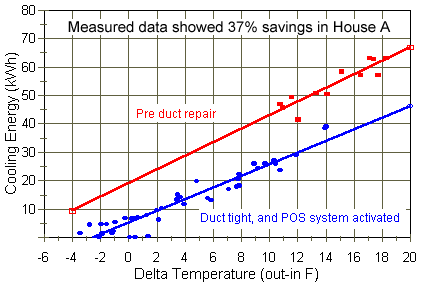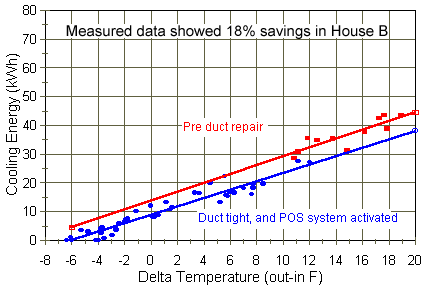Side-by-side Comparison of Manufactured Homes
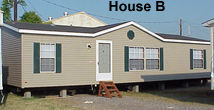 The
primary goal of the BAIHP is to improve the energy efficiency,
durability and indoor air quality of HUD code manufactured
homes. In cooperation with York International, Manufactured
Housing Division (now Style Crest) and Fleetwood
Homes, BAIHP monitored two nearly identical, side-by-side,
unoccupied manufactured homes in Bossier City, Louisiana,
near Shreveport. The goal was to investigate moisture-related
problems and cooling energy use in a hot, humid climate.
The primary difference between the homes was the cooling
equipment. House A had a standard split air conditioner,
while House B had a more efficient two-speed split air
conditioner. All other aspects of the homes were kept the
same. Data loggers in each home operated for two months
collecting information such as:
The
primary goal of the BAIHP is to improve the energy efficiency,
durability and indoor air quality of HUD code manufactured
homes. In cooperation with York International, Manufactured
Housing Division (now Style Crest) and Fleetwood
Homes, BAIHP monitored two nearly identical, side-by-side,
unoccupied manufactured homes in Bossier City, Louisiana,
near Shreveport. The goal was to investigate moisture-related
problems and cooling energy use in a hot, humid climate.
The primary difference between the homes was the cooling
equipment. House A had a standard split air conditioner,
while House B had a more efficient two-speed split air
conditioner. All other aspects of the homes were kept the
same. Data loggers in each home operated for two months
collecting information such as:
- Weather conditions
- Indoor air temperature & relative humidity
- Whole house & cooling equipment energy use
- Pressure differences across the building envelope
- Detailed air conditioner performance measurements
Notice: These experiments were conducted in late summer of 2000. While the results were encouraging, they are less than conclusive due to temperature extremes, unreliable t-stat operation, and simultaneous multiple variable changes. Additional research is needed, using identical side-by-side homes, before robust conclusions can be developed.
Cooling Energy Savings
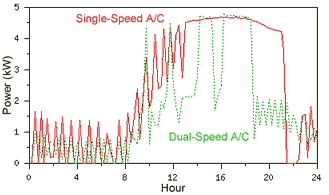
The
figure at left shows the reduced power draw of the dual-speed
compressor (green, dotted line) over a 24-hour period on
September 2, 2000. With the two-speed unit operating at
low-speed for most of the day, the cooling energy savings
were 28%. Average daily cooling energy was reduced by about
12% over the entire monitored period. An extra benefit of
the dual-speed air conditioner was 20% more moisture removal
on days with outdoor dewpoints above 60F. This resulted
from the more consistent compressor runtime in low-speed
mode.
Savings from Duct Repair
While parts of the experiment involved comparing one house to the other, another part looked at home performance before and after some specific changes to the air conditioning ductwork. Most manufactured homes use a central heat and air system with ductwork that is either in the attic or in the belly cavity of the home. Air leakage from the ductwork can cause a variety of moisture-related problems and can increase heating and cooling costs considerably. Leaks may occur at the connection points of the AHU to the main trunk, the boots to the trunk, the boots to the supply registers, end caps, crossover duct connections and other connection points in the duct work.
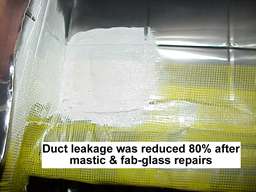 The picture at right shows duct repair using mastic and
fab-glass. Duct leakage was reduce by 80% after repairs
which had an impact on air flow, indoor temperature and
relative humidity, as well as cooling energy.
The picture at right shows duct repair using mastic and
fab-glass. Duct leakage was reduce by 80% after repairs
which had an impact on air flow, indoor temperature and
relative humidity, as well as cooling energy.
In addition to duct repair, the ventilation method in each home was changed from exhaust-only to a positive pressure (POS) ventilation system. With exhaust-only ventilation, exhaust fans in the bathrooms remove stale air from the home which in turn causes fresh air to infiltrate through the building envelope. In this test, two bath exhaust fans were operated by timer for 3 hours in the morning and 6 hours in the evening to simulate occupant use.
A positive pressure (POS) ventilation system was installed in each home on the same day the ducts were repaired. In contrast to exhaust ventilation, the POS system introduces a small amount of fresh air on the return side of the air conditioning cooling coil.
The following graphs show daily cooling energy (kWh) as a function of the outdoor to indoor temperature difference (F). Tightening the ducts and replacing the existing exhaust ventilation with a positive pressure (POS) ventilation system resulted in 37% and 18% cooling savings in the two homes. Only about 2% of these savings can be attributed to the change in ventilation system. The remainder of the savings are a result of duct repair.
